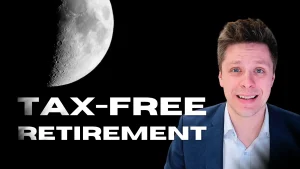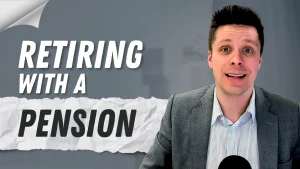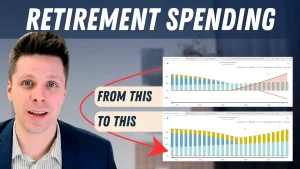[vc_row][vc_column][vc_video link=”https://youtu.be/uj4W_H8q118″ css=”.vc_custom_1673225605045{padding-top: 20px !important;padding-bottom: 20px !important;}”][/vc_column][/vc_row][vc_row][vc_column][vc_column_text]When the stock market goes through a bad year, it becomes increasingly difficult to make withdrawals from your portfolio. So, what’s the best way to make retirement withdrawals during a bad market?
We’re all familiar with the investing adage to buy low and sell high, but without proper planning, you might find yourself in a situation where you a forced to sell when the stock market is down.
Today we’ll be going over two common ways retirees are forced to sell their investments when the market is down, and at the end, we’ll go over how to best set yourself up to make withdrawals during future down markets.
1st Issue
The first issue we see is oversimplification. Let me know if this scenario sounds familiar.
Bob is recently retired and would like to invest the proceeds of his pension. He meets an investment advisor, and they go through a risk profile questionnaire to determine Bob’s comfort level with investing. He answers about ten questions, and it turns out he is a balanced investor, at which point a balanced investment is recommended.
Bob agrees with the recommendation and is now invested in the XYZ Balanced Fund. He also makes monthly withdrawals from the fund to pay for his retirement expenses.
A balanced investor typically has 60% of their money in stocks and 40% in fixed-income investments. The stock portion can fluctuate quite a bit in value, whereas the fixed-income amount should be more consistent.
The issue with XYZ Balanced Fund is that the stock and fixed-income portions are combined into one investment.
If XYZ Balanced Fund has a negative return, Bob will be making withdrawals in a down position.
Looking back on 2022, it wouldn’t have been pretty for Bob.
The problem with oversimplification
Here are the returns for Canada’s largest mutual fund in 2022, which happens to be a balanced fund.[/vc_column_text][dt_fancy_image image_id=”9270″ width=”1250″ css=”.vc_custom_1673286241257{padding-top: 20px !important;padding-bottom: 20px !important;}”][/vc_column][/vc_row][vc_row][vc_column][vc_column_text]
Source: Ycharts
By the end of the year, the fund was down over 12.5%, and at its worst, it was down over 17%. Every time Bob made a withdrawal in 2022, he was pulling money out of his portfolio in a loss position.
To summarize, Bob only has one position, and if his fund is down, he’ll be making withdrawals in a loss position.
2nd Issue
The second way we see retirees being forced to sell their investments when the market is down is a lack of a retirement plan. This often happens when the investment plan is not aligned with the retirement plan.
For example, Sandra has been drawing $4,000 per month from her portfolio. However, she would like to withdraw an extra $35,000 to purchase a vehicle.
Sandra’s investment advisor had never built her a retirement plan, so he was unaware that she had been planning to make this purchase. The advisor was forced to sell a portion of her stock position to provide her with the cash to make the purchase.
If the stock market were down at that point, the withdrawal would have occurred at a loss.
How can you make withdrawals in a bad market?
There are two components to look at for a successful retirement withdrawal plan. The investment portfolio and the retirement plan. They both need to be in line with each other.
Step 1
Step 1 is the retirement plan. A retirement plan allows you to project your future expenses. This, in turn, enables you to determine how much you’ll need to draw on your portfolio every year.
For example, Mr & Mrs. Baker have retired and built a plan that goes over their cash needs in retirement.
[/vc_column_text][dt_fancy_image image_id=”9272″ width=”1250″ css=”.vc_custom_1673286450251{padding-top: 20px !important;padding-bottom: 20px !important;}”][vc_column_text]As we can see, they are receiving income from CPP & OAS and making withdrawals from their RRIFs and TFSAs to pay for their day-to-day expenses. Their withdrawals are consistent, rising slightly every year with inflation.
The only outlier is in 2025, as they plan to purchase a new vehicle.
Once the retirement plan is built, the investment plan can be created to line up with these withdrawals.
What does that mean?
The issue Bob was having was that his entire portfolio was in one balanced investment. If his investment was down, he was forced to make withdrawals in a loss position.
Rather than having all of his eggs in one basket, Bob would have been better served to have multiple investments that coincide with when he requires the funds. After all, the money he needs next month or next year shouldn’t be invested the same as the money he’ll require ten years from now.
We call this the bucketing strategy.
Step 2: The bucketing strategy
The bucketing strategy entails three buckets:
The first bucket is meant for funds expected to be used within a couple of years. If we go back to the Baker’s plan, we can see that they require just over $26k from their portfolio in 2023 and slightly more in 2024. Since they need these funds in a relatively short amount of time. This piece of their retirement portfolio should be invested extremely conservatively, such as in a savings account.
The second bucket is for funds expected to be spent in years 3-7 of their retirement. In the Baker’s case, these are the funds that they’ll need from 2025 to 2029. Similarly, they would need to calculate how much they expect to withdraw from their portfolio in those years. Since these funds are required relatively soon, this bucket should be invested conservatively.
The third bucket is the money the Baker’s will require for the remainder of their retirement. Since they don’t need to touch this piece of their portfolio for many years, it can be invested more aggressively.
You can check out this video for a more detailed breakdown of the bucketing strategy.
Summary
Step 1 is to have a plan that covers your retirement income needs. Once the plan is in place, the investment portfolio can be built to coincide with the required cash flows by using the bucketing strategy.[/vc_column_text][/vc_column][/vc_row][vc_row][vc_column][/vc_column][/vc_row]





